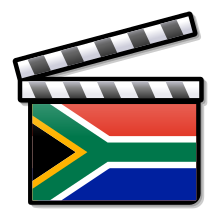| Cinema of South Africa | |
|---|---|
 | |
| No. of screens | 857 (2010)[1] |
| • Per capita | 1.9 per 100,000 (2010)[1] |
| Main distributors | Ster-Kinekor 38.8% Nu-Metro 35.7% Uip 21.7%[2] |
| Produced feature films (2016)[3] | |
| Total | 28 |
| Number of admissions (2011)[4] | |
| Total | 22,400,000 |
| Gross box office (2016)[3] | |
| Total | R1.14 billion |
| National films | R69 million (6%) |
The cinema of South Africa refers to the films and film industry of South Africa. Films have been made in English and Afrikaans (List of Afrikaans-language films). Many foreign films have been produced about South Africa, including many involving race relations.
The first South African film to achieve international acclaim and recognition was the 1980 comedy The Gods Must Be Crazy, written, produced and directed by Jamie Uys. Set in the Kalahari, it told the story about how life in the community of Bushmen is changed when a Coke bottle, thrown out of an airplane, suddenly lands from the sky. Despite the fact that the film presented an incorrect perspective of the Khoisan san people, by framing them as a primitive society enlightened by the modernity of a falling Coke bottle. The late Jamie Uys, who wrote and directed The Gods Must Be Crazy, also had success overseas in the 1970s with his films Funny People and Funny People II, similar to the TV series Candid Camera in the United States. Leon Schuster's You Must Be Joking! films are in the same genre, and were popular among the white population of South Africa during apartheid.
Another high-profile film portraying South Africa was District 9 in 2009. Directed by Neill Blomkamp, a native South African, and produced by The Lord of the Rings trilogy director Peter Jackson, the action/science-fiction film depicts a sub-class of alien refugees forced to live in the slums of Johannesburg in what many saw as a creative allegory for apartheid. The film was a critical and commercial success worldwide, and was nominated for four Academy Awards, including Best Picture, at the 82nd Academy Awards.
- ^ a b "Table 8: Cinema Infrastructure – Capacity". UNESCO Institute for Statistics. Archived from the original on 24 December 2018. Retrieved 5 November 2013.
- ^ "Box Office Report: South Africa (January – December 2013)". National Film and Video Foundation South Africa. Archived from the original (PDF) on 7 October 2020. Retrieved 14 August 2014.
- ^ a b "South African Box Office 2016" (PDF). National Film and Video Foundation. Archived from the original (PDF) on 13 September 2017. Retrieved 15 January 2018.
- ^ "Table 11: Exhibition – Admissions & Gross Box Office (GBO)". UNESCO Institute for Statistics. Archived from the original on 24 December 2018. Retrieved 5 November 2013.